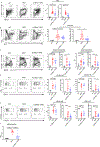Interleukin-13 Receptor α1-Mediated Signaling Regulates Age-Associated/Autoimmune B Cell Expansion and Lupus Pathogenesis
- PMID: 35438841
- PMCID: PMC9427689
- DOI: 10.1002/art.42146
Interleukin-13 Receptor α1-Mediated Signaling Regulates Age-Associated/Autoimmune B Cell Expansion and Lupus Pathogenesis
Abstract
Objective: Age-associated/autoimmune B cells (ABCs) are an emerging B cell subset with aberrant expansion in systemic lupus erythematosus. ABC generation and differentiation exhibit marked sexual dimorphism, and Toll-like receptor 7 (TLR-7) engagement is a key contributor to these sex differences. ABC generation is also controlled by interleukin-21 (IL-21) and its interplay with interferon-γ and IL-4. This study was undertaken to investigate whether IL-13 receptor α1 (IL-13Rα1), an X-linked receptor that transmits IL-4/IL-13 signals, regulates ABCs and lupus pathogenesis.
Methods: Mice lacking DEF-6 and switch-associated protein 70 (double-knockout [DKO]), which preferentially develop lupus in females, were crossed with IL-13Rα1-knockout mice. IL-13Rα1-knockout male mice were also crossed with Y chromosome autoimmune accelerator (Yaa) DKO mice, which overexpress TLR-7 and develop severe disease. ABCs were assessed using flow cytometry and RNA-Seq. Lupus pathogenesis was evaluated using serologic and histologic analyses.
Results: ABCs expressed higher levels of IL-13Rα1 than follicular B cells. The absence of IL-13Rα1 in either DKO female mice or Yaa DKO male mice decreased the accumulation of ABCs, the differentiation of ABCs into plasmablasts, and autoantibody production. Lack of IL-13Rα1 also prolonged survival and delayed the development of tissue inflammation. IL-13Rα1 deficiency diminished in vitro generation of ABCs, an effect that, surprisingly, could be observed in response to IL-21 alone. RNA-Seq revealed that ABCs lacking IL-13Rα1 down-regulated some histologic characteristics of B cells but up-regulated myeloid markers and proinflammatory mediators.
Conclusion: Our findings indicate a novel role for IL-13Rα1 in controlling ABC generation and differentiation, suggesting that IL-13Rα1 contributes to these effects by regulating a subset of IL-21-mediated signaling events. These results also suggest that X-linked genes besides TLR7 participate in the regulation of ABCs in lupus.
© 2022 American College of Rheumatology.
Figures




References
Publication types
MeSH terms
Substances
Grants and funding
LinkOut - more resources
Full Text Sources
Medical
Molecular Biology Databases

